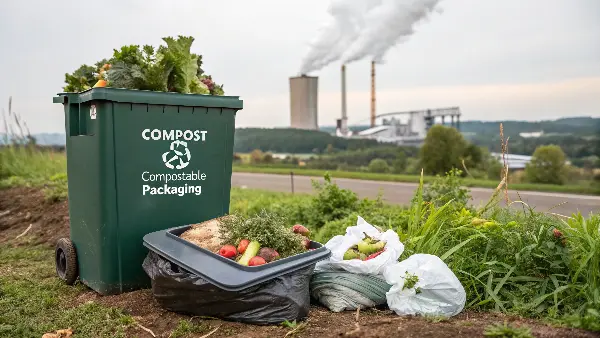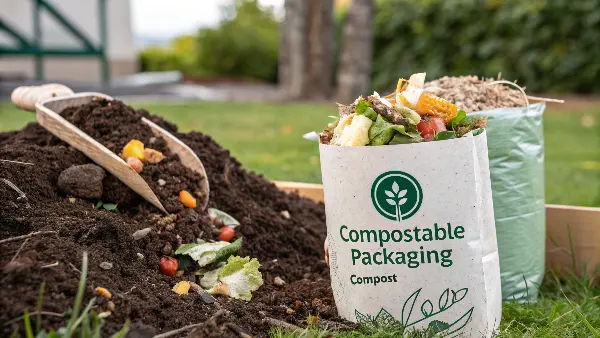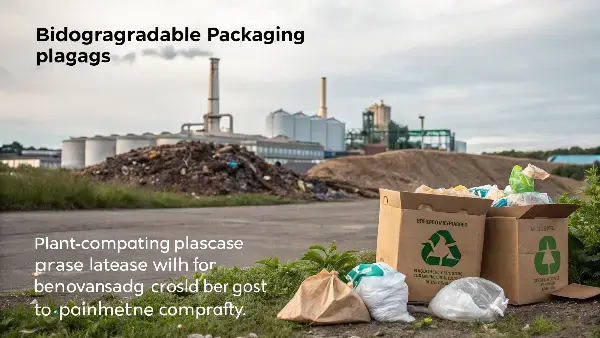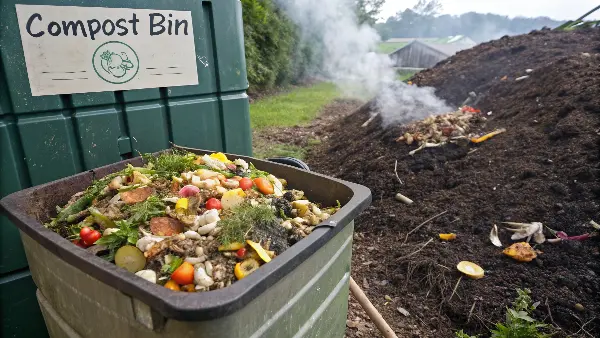Your business is pushing for stronger ESG goals, but your packaging is holding you back. Traditional plastics create a huge carbon footprint, from production to disposal. This puts your brand’s sustainable mission at risk and makes it hard to stand out. Shifting to compostable packaging is the clear, impactful solution you need to align your products with your values.
Compostable packaging significantly reduces greenhouse gases by diverting organic waste, including the packaging itself, from landfills. In landfills, this waste would produce methane, a potent greenhouse gas. Instead, composting creates a nutrient-rich soil amendment, sequestering carbon in the soil and avoiding methane emissions. This process also reduces the carbon footprint associated with manufacturing traditional petroleum-based plastics, creating a much greener lifecycle from start to finish for your products.

As a B2B supplier of sustainable products, I talk with packaging specialists like Jacky in Canada every day. They’re sharp, they know their materials, and they’re always looking for an edge that benefits both their brand and the planet. They understand that making a real impact isn’t just about a single choice, but about understanding the entire system. Let’s break down how compostable packaging fits into this bigger picture of sustainability and greenhouse gas reduction.
What are the benefits of compostable packaging?
You want to make the switch to sustainable packaging, but the options feel overwhelming. It’s tough to know which choice truly makes a difference and aligns with your company’s green initiatives. You need a solution that is not only eco-friendly but also practical for your business and clear for your customers, demonstrating a real commitment to change.
The main benefits of compostable packaging include reducing landfill waste, lowering greenhouse gas emissions, and enriching soil when properly composted. It’s made from renewable resources like cornstarch or bagasse, which lessens our dependence on fossil fuels. For businesses, it enhances brand image by meeting consumer demand for sustainability and helps achieve corporate ESG (Environmental, Social, and Governance) goals. This makes it a smart choice for both the planet and your bottom line.

When I first started in this industry, the conversation was just about "being green." Now, it’s about specifics. It’s about data. It’s about the entire lifecycle of a product. Compostable packaging isn’t just a feel-good choice; it’s a strategic one with measurable advantages that resonate with today’s environmentally-conscious market. The benefits go far beyond just avoiding plastic. They create a positive feedback loop that strengthens the environment, your brand, and your relationship with customers.
Building a Circular Economy
One of the most powerful benefits is that compostable packaging is designed for a circular system, not a linear one. Traditional packaging follows a "take-make-waste" model. We take resources, make a product, and then throw it away. Compostable items, especially in the food service industry, create a "take-make-return to earth" model. Food scraps and packaging go into the same bin. They are then processed together to become compost, which returns valuable nutrients to the soil. This closes the loop.
Improving Your ESG Score
For companies that are publicly traded or seeking investment, ESG scores are critical. Compostable packaging is a tangible, highly visible way to improve your environmental metrics.
- Environmental: Using renewable, plant-based materials directly lowers your carbon footprint from raw material extraction. Diverting waste from landfills cuts methane emissions.
- Social: It shows your customers and employees that you are a responsible company that cares about its impact.
- Governance: It demonstrates a proactive approach to environmental regulation and risk management.
I’ve worked with brands that saw their ESG scores climb after making a dedicated switch. It sends a clear message that you’re not just talking about sustainability—you’re actively building it into your operations.
How does biodegradable packaging help the environment?
Many companies hear "biodegradable" and think it’s the perfect green solution. But the term can be confusing and sometimes misleading. If not handled correctly, these products can end up causing more harm than good in landfills or recycling streams. You need clarity on what "biodegradable" truly means and how it can genuinely benefit the environment, not just sound good on a label.
Biodegradable packaging helps the environment primarily by breaking down into natural elements over time, reducing long-term plastic pollution. When derived from plant-based sources like PLA or bagasse, its production also relies on renewable resources, decreasing the demand for fossil fuels. However, its greatest environmental benefit is realized when it is disposed of in specific conditions, such as an industrial composting facility, where its breakdown can be managed to avoid methane release and create useful compost.

I often have to clarify the distinction between "biodegradable" and "compostable" for clients. Think of it this way: all compostable items are biodegradable, but not all biodegradable items are compostable. "Biodegradable" simply means something can be broken down by microorganisms. But it doesn’t specify the time frame or the conditions. "Compostable," on the other hand, means it will break down in a composting environment within a specific time (like 90-180 days) into non-toxic components. For real environmental impact, we always steer clients toward certified compostable products.
The Problem with Landfills
The key environmental benefit hinges on how a product breaks down. In a landfill, there is very little oxygen. When biodegradable materials decompose anaerobically (without oxygen), they release methane. Methane is a greenhouse gas over 25 times more potent than carbon dioxide. So, a biodegradable cup in a landfill might actually be worse for climate change than a plastic one in the short term. This is why proper disposal is everything. Certified compostable packaging is designed to avoid this exact problem by breaking down in an oxygen-rich compost environment.
Reducing Reliance on Fossil Fuels
| Let’s look at the beginning of the product’s life. Most biodegradable packaging we work with at Ecosourcecn is made from renewable, plant-based materials. | Material | Source | Key Advantage |
|---|---|---|---|
| PLA (Polylactic Acid) | Cornstarch, sugarcane | Lower carbon footprint in production | |
| Bagasse | Sugarcane fiber waste | Upcycles an agricultural byproduct | |
| Kraft Paper | Sustainably sourced wood pulp | Renewable and often compostable |
By using these materials, we skip the entire fossil fuel extraction and refining process that’s required for conventional plastics like PET or polystyrene. This drastically reduces the greenhouse gas emissions associated with manufacturing from the very start. It’s a fundamental shift in our resource dependency.
How does composting contribute to reducing greenhouse gas emissions?
Your business ships food products, and the packaging often ends up covered in residue, making it unrecyclable. This means both the food scraps and the packaging are destined for the landfill. There, they generate methane, a powerful greenhouse gas, directly contributing to your company’s carbon footprint. You need a way to break this wasteful cycle.
Composting contributes to reducing greenhouse gas emissions primarily by diverting organic waste from landfills. In an oxygen-deprived landfill environment, decomposing organic matter produces methane (CH₄), a greenhouse gas far more potent than carbon dioxide. Composting is an aerobic process (with oxygen) that avoids methane production almost entirely. Instead, it breaks down organic material into stable carbon, water, and CO₂, which is part of the natural biogenic carbon cycle and less harmful.

When talking to sustainability managers, this is the point that really clicks. The problem isn’t just the plastic itself; it’s the system it forces us into. When you package a salad in a plastic container, the leftover dressing and bits of lettuce contaminate the plastic. It can’t be recycled. So, the plastic and the food scraps go to the landfill. By switching to a compostable container, you create a new, much better pathway. The container and any leftover food can go into the same organics bin. This simple change has a massive impact on greenhouse gas emissions.
The Landfill vs. Compost Pile
Understanding the difference between anaerobic and aerobic decomposition is key. It’s a bit of science, but it’s simple to grasp and critical for making informed packaging choices.
-
Anaerobic Decomposition (Landfill): Imagine burying food waste deep under layers of trash. There’s no air. Microbes that thrive in this environment break down the waste and release methane (CH₄) as a byproduct. Some landfills have methane capture systems, but many do not, and they aren’t 100% efficient. Methane leaks directly into the atmosphere, where it’s a major driver of global warming.
-
Aerobic Decomposition (Compost Pile): Now, imagine that same food waste in a properly managed compost pile. It’s mixed with other materials like leaves and wood chips and turned regularly to introduce oxygen. Here, a different set of microbes takes over. They break down the waste efficiently and release mainly carbon dioxide (CO₂), water, and heat. This biogenic CO₂ is part of the natural carbon cycle—the same CO₂ the plants absorbed while growing—so it doesn’t add new carbon to the atmosphere over its lifecycle.
By choosing composting, you are essentially swapping a high-impact greenhouse gas (methane) for a neutral one.
What is the potential role of compost in reducing greenhouse gases?
You’ve successfully diverted waste from landfills by using compostable packaging, which is a great first step. But the journey doesn’t end there. The final product of this process—compost—is often overlooked. You might not realize that this nutrient-rich soil amendment has its own powerful role to play in the fight against climate change, creating even more value from your initial sustainable choice.
The compost created from organic waste plays a vital role in reducing greenhouse gases through carbon sequestration. When applied to soil, compost improves its structure and health, enabling it to store more carbon and keep it out of the atmosphere. Healthy, compost-amended soil also reduces the need for synthetic chemical fertilizers, whose production is energy-intensive and generates significant greenhouse gas emissions. This turns a waste product into a powerful climate solution for agriculture and land management.

This is the part of the story that I find most exciting and one that many partners like Jacky are starting to focus on. We’ve moved beyond just "waste diversion." We’re now talking about "resource creation." The compostable fork or container isn’t just avoiding a negative (landfill methane); it’s contributing to a positive (healthier soil and carbon capture). This completes the circular economy model and shows how a simple packaging choice can have far-reaching environmental benefits that last for years. It’s a story that resonates powerfully with consumers.
Turning Soil into a Carbon Sink
Soil is one of the largest carbon reservoirs on the planet. However, industrial farming practices have degraded many soils, causing them to release carbon into the atmosphere. Compost helps reverse this trend.
- Adding Organic Matter: Compost is essentially stabilized organic matter. When you mix it into soil, you are directly adding carbon back into the ground.
- Improving Soil Structure: The organic matter in compost helps soil particles clump together. This creates a more porous structure that can hold more air and water, making it healthier for plants and microbes.
- Fueling Microbial Life: A healthy soil ecosystem is teeming with fungi and bacteria. These microorganisms use carbon to build their bodies and create compounds that bind carbon to soil particles for the long term.
By enhancing soil’s ability to store carbon, we turn farms, parks, and even gardens into active "carbon sinks," pulling CO₂ out of the atmosphere.
Reducing the Need for Synthetic Fertilizers
The production of nitrogen-based fertilizers is an incredibly energy-intensive process that relies on natural gas. It’s estimated to be responsible for over 1% of total global greenhouse gas emissions. Compost provides a natural alternative. It releases nutrients slowly and provides a wide range of micronutrients that synthetic fertilizers lack. By improving soil fertility naturally, compost reduces the demand for these carbon-heavy industrial fertilizers, cutting emissions at their source.
Conclusion
Switching to compostable packaging is more than just an eco-friendly choice; it’s a powerful business strategy. It directly reduces methane from landfills, cuts our reliance on fossil fuels, and helps rebuild healthy soils that capture carbon. This single change can strengthen your brand’s ESG performance and show a clear commitment to a truly circular and sustainable future.


